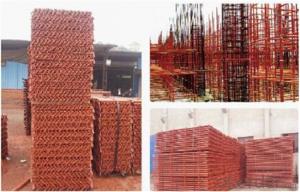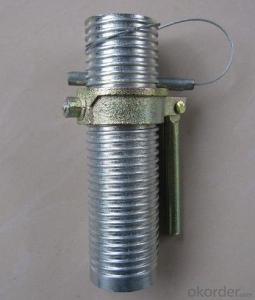Fixed Scaffold Clamp Britis German Forged Type
- Loading Port:
- Tianjin
- Payment Terms:
- TT OR LC
- Min Order Qty:
- 1000 kg
- Supply Capability:
- 100000 kg/month
OKorder Service Pledge
OKorder Financial Service
You Might Also Like
Description
1.The scaffolding coupler is always used to connect the steel pipe as scaffolding system.
2.The often used coupler is swivel coupler and righ angle coupler .
3.We can provide types of scaffolding coupler according to your requirement.
4.Couoler can fix the 48.3mm scaffolding steel pipe tightly and make the whole scaffolding system more steadily.
Feature
(1)Excellent Anti-Breaking—Cold Pressed Steel
(2)Outstanding Resistance Deformation
(3)Strong Anti-Dropping Ability
Photo

Parameter
| Material | Q235,345steel |
| Size | 48.3mm*48.3mm |
| Surface finish | Galvanized |
| Weight | 1.1kg around |
| Standard | BS1139,EN74 |
| Package | 25pcs/bag,steel pallet |
| Manufacture | As per customer requirement |
| Market | Africa, South America, the Middle East and Asia |
FAQ
Q: Are you a factory or trading company?
We are a state-owned corporation in China,dealing with various kinds of building materials.We have our holding subsidiaries.
Q: Where is your factory located? How can I visit there?
Our factory is located all around China.
Q: Can I get some samples?
Sample is free, customer only pay freight for the first time.
Q: Delivery?
10-30days. (5-15 containers)
Any question,feel free to contact us.
- Q: Can steel tube couplers be used for both straight and angled connections in scaffolding?
- Steel tube couplers have the capability to be utilized for both straight and angled connections in scaffolding. They possess versatility and enable the joining of steel tubes at different angles, thereby facilitating the construction of multi-directional scaffolding structures. These couplers are specifically engineered to establish a steadfast and dependable connection, guaranteeing the stability and safety of the scaffolding system. Regardless of whether it is for straight or angled connections, steel tube couplers are a prevalent and extensively employed element in the construction of scaffolding.
- Q: How do steel tube couplers ensure proper load distribution and stability in scaffolding structures with irregular or unbalanced loads?
- Proper load distribution and stability in scaffolding structures heavily rely on the pivotal role of steel tube couplers. These couplers are of utmost importance when dealing with irregular or unbalanced loads, as they are specifically designed to connect and secure steel tubes, creating a framework that is both robust and trustworthy. To achieve load distribution, steel tube couplers distribute the weight evenly across multiple tubes. When irregular or unbalanced loads are applied to the scaffolding structure, different forces are exerted, which can potentially lead to instability if not properly distributed. By connecting the tubes using couplers, the load is spread out and shared among the tubes, preventing any single tube from bearing an excessive amount of weight. In addition, steel tube couplers ensure stability by effectively transferring forces and loads between the tubes. When irregular or unbalanced loads are present, there is a risk of twisting or bending, which can compromise the stability of the structure. However, by employing couplers, the forces and loads are transmitted between the tubes, ensuring that the structure remains stable and secure. Furthermore, steel tube couplers offer versatility by accommodating different configurations and angles. In situations where irregular or unbalanced loads are present, it may be necessary to connect tubes at various angles or positions. Couplers allow for flexibility in connecting these tubes together, enabling the scaffolding to adapt to the specific load requirements and maintain stability. Lastly, the strength and durability of steel tube couplers play a significant role in ensuring proper load distribution and stability. These couplers are typically constructed from high-quality steel, which provides the necessary strength and rigidity to withstand heavy loads and maintain structural integrity. The secure connection facilitated by the couplers prevents any shifting or movement that could put the stability of the scaffolding structure at risk. In conclusion, steel tube couplers are vital components in scaffolding structures, as they ensure proper load distribution and stability in the presence of irregular or unbalanced loads. They achieve this by evenly distributing the weight, transferring forces between tubes, accommodating different configurations and angles, and providing strength and durability. The safety and reliability of scaffolding systems heavily rely on these couplers, as they allow the structures to withstand challenging load conditions.
- Q: Are steel tube couplers compatible with scaffolding systems from different manufacturers?
- Most scaffolding systems from various manufacturers can be used with steel tube couplers, as these couplers adhere to standard dimensions and specifications set by industry organizations like the National Access and Scaffolding Confederation (NASC) and the Occupational Safety and Health Administration (OSHA). These regulations guarantee that steel tube couplers can be interchanged between different manufacturers' scaffolding systems, given they meet the industry's standards. Nonetheless, it is advisable to refer to the specific manufacturer's guidelines and specifications for proper compatibility and safety assurance.
- Q: Are steel tube couplers compatible with different scaffold tube sizes?
- Yes, steel tube couplers are designed to be compatible with different scaffold tube sizes. They are adjustable and can be used to connect tubes of varying diameters securely and safely.
- Q: Are steel tube couplers resistant to extreme weather conditions?
- Yes, steel tube couplers are generally resistant to extreme weather conditions. Steel is known for its durability and strength, which enables the couplers to withstand harsh weather such as heavy rain, snow, extreme heat, and high winds. However, specific factors like the quality of the steel, proper installation, and regular maintenance can also impact their overall resistance to extreme weather conditions.
- Q: Are steel tube couplers suitable for both residential and commercial scaffolding applications?
- Yes, steel tube couplers are suitable for both residential and commercial scaffolding applications. They provide a secure and reliable connection between scaffold tubes, ensuring stability and safety for workers in various construction settings.
- Q: What are the typical weight limits for steel tube couplers in scaffolding applications?
- The typical weight limits for steel tube couplers in scaffolding applications vary depending on their specific design and manufacturer. However, most steel tube couplers used in scaffolding can typically support loads ranging from 1,500 to 4,000 pounds (680 to 1,814 kilograms). It is important to consult the manufacturer's specifications and guidelines to ensure that the weight limits are not exceeded for safe and effective scaffolding operations.
- Q: How do steel tube couplers affect the overall visibility of a scaffolding structure during use?
- Steel tube couplers can have a significant impact on the overall visibility of a scaffolding structure during use. These couplers are used to join the steel tubes that make up the scaffolding system, ensuring stability and safety. However, their presence can obstruct the line of sight for workers and supervisors on the scaffolding. Due to their size and shape, steel tube couplers can create blind spots and limit visibility in certain areas of the scaffolding structure. This can affect the ability of workers to see potential hazards or obstacles on the scaffolding, as well as hinder communication between different parts of the structure. It can also make it more difficult for supervisors to monitor the work being done and ensure compliance with safety regulations. To mitigate this issue, it is important to consider the placement and arrangement of the steel tube couplers during the design and construction of the scaffolding. By strategically positioning the couplers and ensuring they do not obstruct crucial lines of sight, visibility can be improved. Additionally, the use of proper lighting and reflective materials can enhance visibility and help workers identify potential hazards even in areas where the couplers may obstruct the view. Regular inspections and maintenance of the scaffolding structure are also essential to ensure that any couplers that might have shifted or become loose are promptly identified and repositioned. This will help maintain optimal visibility throughout the lifespan of the scaffolding. Overall, while steel tube couplers are necessary for the stability and integrity of a scaffolding structure, they can impact its overall visibility. However, with proper planning, design, and maintenance, the negative effects can be minimized, allowing for a safer and more efficient working environment.
- Q: How do steel tube couplers affect the overall cost of scaffolding projects?
- Steel tube couplers can have a significant impact on the overall cost of scaffolding projects. These couplers are essential components that connect the steel tubes, forming a sturdy and reliable structure. The cost of steel tube couplers can vary depending on factors such as the type and quality of the couplers, the quantity needed, and the supplier. One aspect that affects the cost is the type of steel tube couplers used. There are various types available, including swivel couplers, sleeve couplers, putlog couplers, and beam clamps. Each type has its own specifications, applications, and cost. For example, swivel couplers are typically more expensive than sleeve couplers due to their added flexibility and adjustable features. The quality of the steel tube couplers also plays a role in the overall cost. High-quality couplers are typically more expensive but offer better durability, strength, and resistance to corrosion. Investing in superior quality couplers can lead to longer-lasting scaffolding structures, reducing the need for frequent replacements and maintenance, thus potentially lowering overall costs in the long run. The quantity of steel tube couplers needed for a particular project directly affects the cost. Large-scale projects that require a significant amount of scaffolding will naturally require a greater number of couplers, resulting in higher costs. It is essential to accurately estimate the quantity needed to avoid over-purchasing and unnecessary expenses. Lastly, the choice of supplier can impact the cost of steel tube couplers. Different suppliers may offer varying prices for identical or similar products. It is crucial to research and compare prices from multiple suppliers to ensure that the best value for money is obtained. Overall, steel tube couplers can significantly affect the cost of scaffolding projects. Factors such as the type, quality, quantity, and supplier of the couplers should be carefully considered to optimize costs while maintaining the required safety and reliability of the scaffolding structure.
- Q: How do steel tube couplers ensure the stability and rigidity of scaffolding structures during use?
- Steel tube couplers ensure the stability and rigidity of scaffolding structures during use by providing a secure connection between the steel tubes. These couplers are designed to grip the tubes tightly, preventing any movement or slippage. This ensures that the scaffolding remains stable and rigid, even when subjected to various loads and forces. The strong and reliable connection created by the couplers enhances the overall structural integrity of the scaffolding, ensuring the safety of workers and the stability of the platform.
Send your message to us
Fixed Scaffold Clamp Britis German Forged Type
- Loading Port:
- Tianjin
- Payment Terms:
- TT OR LC
- Min Order Qty:
- 1000 kg
- Supply Capability:
- 100000 kg/month
OKorder Service Pledge
OKorder Financial Service
Similar products
Hot products
Hot Searches
Related keywords



























